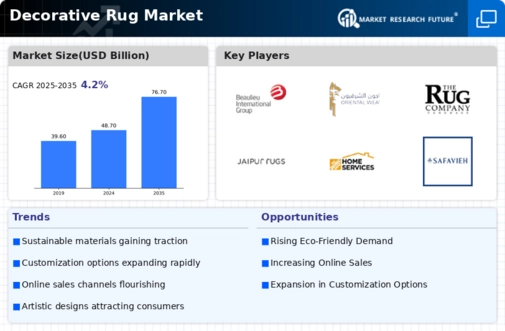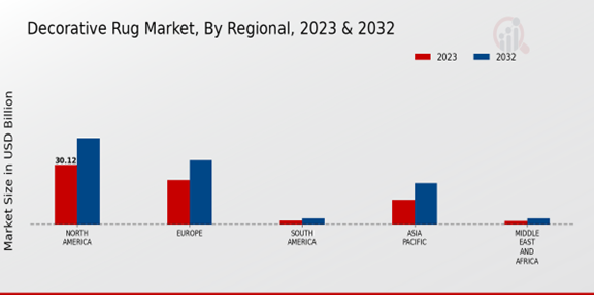Market Growth Projections
The Global Decorative Rug Market Industry is poised for substantial growth, with projections indicating a market size of 48.7 USD Billion in 2024 and an anticipated increase to 76.7 USD Billion by 2035. This growth trajectory suggests a compound annual growth rate (CAGR) of 4.22% from 2025 to 2035. Factors such as rising disposable incomes, urbanization, and evolving consumer preferences for home decor contribute to this optimistic outlook. As the market expands, it is likely that new players will enter, further intensifying competition and innovation within the industry.
Growth in E-commerce and Online Retail
The Global Decorative Rug Market Industry is significantly influenced by the rapid growth of e-commerce and online retail platforms. With the convenience of online shopping, consumers are increasingly purchasing decorative rugs through digital channels. This shift allows for a broader selection of products, enabling consumers to explore various styles and price points from the comfort of their homes. The rise of social media and influencer marketing further amplifies this trend, as consumers are exposed to diverse design inspirations. As a result, the market is expected to expand, with projections indicating a growth trajectory that could see it reach 76.7 USD Billion by 2035.
Sustainability Trends in Home Furnishings
Sustainability trends are becoming increasingly prominent within the Global Decorative Rug Market Industry. Consumers are showing a preference for eco-friendly materials and production processes, which has led manufacturers to innovate and adapt their offerings. Rugs made from natural fibers, recycled materials, and sustainable practices are gaining traction among environmentally conscious buyers. This shift not only aligns with global sustainability goals but also caters to a growing demographic that values ethical consumption. As the market evolves, it is likely that sustainable decorative rugs will capture a larger share, reflecting a broader commitment to environmental responsibility in home furnishings.
Technological Advancements in Manufacturing
Technological advancements are transforming the Global Decorative Rug Market Industry by enhancing production efficiency and design capabilities. Innovations in weaving techniques, dyeing processes, and material development allow manufacturers to create high-quality rugs with intricate designs and improved durability. Automation and digital printing technologies enable rapid prototyping and customization, catering to the growing demand for personalized products. As a result, manufacturers can respond more effectively to market trends and consumer preferences. This technological evolution is likely to contribute to the market's growth, with a projected CAGR of 4.22% from 2025 to 2035, indicating a robust future for the industry.
Cultural Influences and Global Design Trends
Cultural influences play a pivotal role in shaping the Global Decorative Rug Market Industry. As globalization continues to facilitate the exchange of ideas and aesthetics, consumers are increasingly drawn to rugs that reflect diverse cultural backgrounds and artistic expressions. This trend is evident in the rising popularity of traditional and artisanal designs, which often incorporate unique patterns and craftsmanship. Additionally, global design trends, such as minimalism and bohemian styles, further influence consumer preferences. The market's adaptability to these cultural nuances suggests a dynamic landscape where decorative rugs serve as both functional items and cultural artifacts.
Rising Consumer Demand for Aesthetic Home Decor
The Global Decorative Rug Market Industry experiences a notable surge in consumer demand for aesthetically pleasing home decor. As individuals increasingly prioritize interior design, decorative rugs serve as essential elements in enhancing the ambiance of living spaces. This trend is particularly evident in urban areas where smaller living spaces necessitate multifunctional decor items. The market is projected to reach 48.7 USD Billion in 2024, reflecting a growing appreciation for unique designs and quality materials. Consumers are gravitating towards rugs that not only provide comfort but also contribute to the overall aesthetic appeal of their homes, indicating a shift towards personalized home environments.













